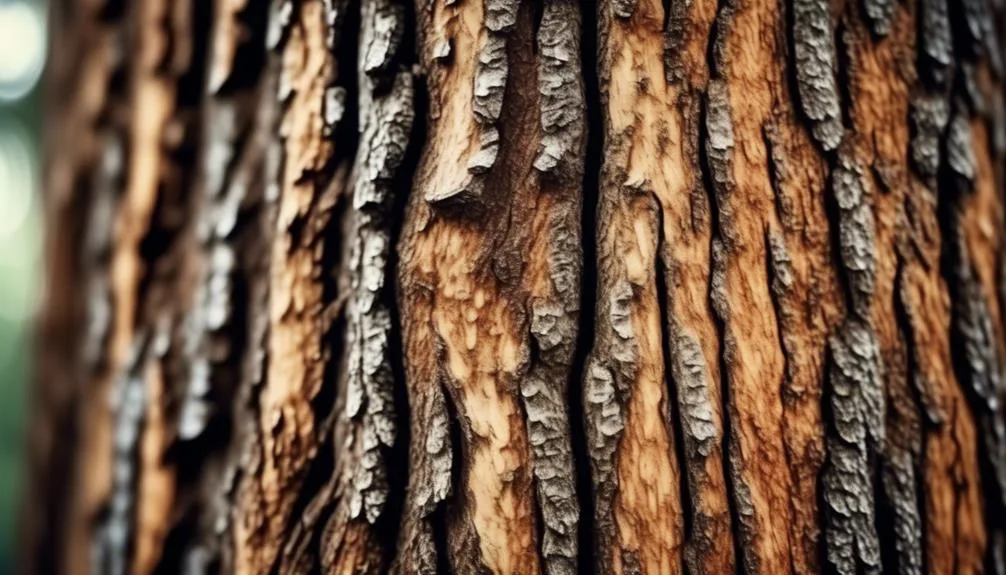Hickory trees, native to North America and part of the walnut family, are known for their unique shaggy bark. This distinctive feature not only adds character but also plays a vital role in the tree's survival.
The reasons behind the shaggy bark are fascinating, offering insights into how hickory trees thrive in their natural habitat. Let's explore the intriguing characteristics and secrets that contribute to the hickory tree's existence.
Hickory Tree Characteristics
Hickory trees boast a distinctive shaggy bark that sets them apart from other tree species in the forest.
But there's more to these trees than just their striking appearance. Hickory trees are renowned for their nut production, yielding delicious and nutritious nuts that are a favorite among wildlife and humans alike.
The wood quality of hickory is exceptional, known for its strength, durability, and shock resistance. This makes it highly sought after for a variety of uses, including furniture, tool handles, and flooring.
The nuts and wood from hickory trees make them not only a valuable resource but also a vital component of the ecosystem.
Their distinctive bark may be what catches your eye, but it's their nut production and wood quality that truly set hickory trees apart.
Function of Shaggy Bark
Why does the shaggy bark of hickory trees play such a crucial role in their survival and success in the forest ecosystem? The shaggy bark serves a variety of functions that aid in the tree's resilience and growth. Here's a breakdown of how the unique texture and composition of hickory bark contribute to the tree's well-being:
| Function | Description |
|---|---|
| Shaggy bark insulation | The shaggy, rough texture of the bark provides insulation, protecting the tree from extreme temperatures. |
| Tree trunk texture | The rough texture also deters pests and climbers, helping to safeguard the tree against potential harm. |
The shaggy bark of hickory trees is not just a visual characteristic, but a vital component that supports the tree's ability to thrive in its natural habitat.
Environmental Adaptations
With its shaggy bark providing insulation and protection, the hickory tree has developed various environmental adaptations to thrive in its natural habitat.
Hickory trees exhibit remarkable climate resilience, allowing them to withstand a range of environmental conditions. Their shaggy bark helps insulate the tree, protecting it from extreme temperatures and moisture loss. This adaptation gives hickory trees an evolutionary advantage by enabling them to thrive in diverse climates, from humid forests to dry, rocky slopes.
The shaggy bark also acts as a defense mechanism against pests and diseases, contributing to the tree's overall resilience. This environmental adaptation has played a crucial role in the hickory tree's ability to survive and flourish in a wide variety of habitats, making it a resilient and enduring species in the natural world.
Protection Against Pests
Adapting to its surroundings, hickory trees develop a natural defense mechanism against pests, utilizing their shaggy bark to protect against invasive insects and potential diseases.
The shaggy bark of hickory trees serves as a physical barrier, making it difficult for pests to infest the tree. This rough texture also provides an inhospitable environment for pests to lay eggs or establish colonies, thus reducing the risk of infestation and damage to the tree.
Additionally, the chemical composition of the bark contains compounds that act as natural repellents, deterring many common pests. Furthermore, hickory trees have evolved to produce secondary metabolites that are toxic or unpalatable to insects, offering an additional layer of pest resistance.
Through these natural defense mechanisms, hickory trees maintain their health and vigor in the face of potential threats from pests.
Growth and Development
The growth and development of hickory trees is influenced by various environmental factors, shaping their form and resilience as they mature.
Root development is crucial for hickory trees, as they develop deep taproots that enable them to access water and nutrients from the soil, providing stability and support as they grow.
Additionally, leaf morphology plays a significant role in their growth and development, as hickory trees have compound leaves with multiple leaflets that maximize their capacity for photosynthesis. These leaves are also adapted to withstand harsh weather conditions and reduce water loss, contributing to the overall resilience of the tree.
As hickory trees continue to grow, these factors work in harmony to shape their unique characteristics and ensure their successful development.
Conclusion
In the wilderness, the shaggy bark of hickory trees isn't just for show; it's a vital defense mechanism. These remarkable adaptations enable hickory trees to thrive in their natural habitats, showcasing the resilience and resourcefulness of nature.
Next time you encounter a hickory tree, take a moment to appreciate the intricate ways it has evolved to overcome challenges and flourish in the wild.
Mark Hoffman is a dedicated arborist and tree care specialist with over a decade of experience. His love for trees began when he visited Yosemite National Park as a teenager and was awestruck by the giant sequoias. Mark pursued his passion by studying forestry at Michigan Technological University, where he earned a Bachelor of Science degree.
Since then, he has worked tirelessly in the field of arboriculture, helping to preserve and protect trees in his community. His expertise and dedication have made him a respected leader in the industry and a valuable resource for anyone seeking advice on tree care.
